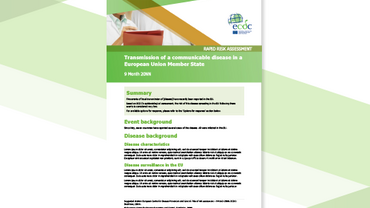Risk of introduction and transmission of wild-type poliovirus in EU/EEA countries following events in Israel and Syria – updated risk assessment (9 December 2013)
The confirmed circulation of wild-type poliovirus (WPV) in Israel and the outbreak of poliomyelitis in Syria mean that there is a high risk the disease will be reintroduced into the EU/EEA. The reintroduction and transmission of WPV in the EU/EEA Member States must be prevented. Following on from two previous ECDC risk assessments and the conclusions of the expert consultation meeting held in Stockholm on 5 November 2013 this risk assessment sets out a number of recommendations and options that EU/EEA Member States can take to reduce the risk of poliovirus transmission and disease in their citizens. The strategies are primarily based on enhancing vaccination of resident and refugee populations, strengthening surveillance and being prepared to respond quickly to the identification of polio.
Executive Summary
The confirmed circulation of wild poliovirus (WPV) in Israel and the outbreak of poliomyelitis in Syria place the EU/EEA at a higher risk for introduction and transmission of the virus and at a moderate one for the reappearance of the disease.
In the updated risk assessment, ECDC brings together and updates previous recent risk assessments (RA of 26 September 2013 and RRA of 24 October 2013) on poliovirus importation and transmission in EU/EEA countries.
The increase of the number of polio cases and countries reporting poliovirus transmission puts EU/EEA Member States at risk for introduction and transmission of the virus.
Vaccination coverage levels in the EU/EEA can be considered satisfactory as a whole - more than 90% for three doses of either the inactivated polio vaccine (IPV) or the oral polio vaccine (OPV) - and can explain the absence of WPV circulation in the region so far. However, there are pockets of un- and under-immunised people and WPV could spread silently in countries with very high IPV immunisation coverage if some portion of the population live in poor living conditions where the virus transmits very efficiently. These living conditions exist among specific population groups in Europe and a similar scenario could occur if poliovirus is re-introduced into the area. Nevertheless, in light of good water sanitation and waste water management the EU/EEA Member States are more likely to see WPV circulation among population groups with low vaccination coverage.
The updated risk assessment also considers and assesses the use of OPV versus IPV vaccination in case of a poliomyelitis outbreak in EU/EEA Member States and makes concrete recommendations for Member States on assessing migrants from areas where WPV is currently circulating.
Recommendations made in the Risk Assessment:
Vaccination/prevention
- EU/EEA Member States should give high priority to the assessment of polio vaccination uptake at national, sub-national and local level, and to the identification of vulnerable and under-vaccinated populations.
- EU Member States receiving refugees and asylum seekers from Syria and other areas where WPV is currently circulating should assess their vaccination status on arrival and provide polio vaccination and other vaccinations as needed.
Surveillance
- Member States to comply with the minimum Acute Flaccid Paralysis (AFP) surveillance standards if this is the only surveillance system in place.
- The role of environmental and enterovirus surveillance should be further discussed at the EU/EEA-level with a view to agreeing on common standards and indicators.
- Member States should consider assessing their current laboratory capacity for polio virus detection.
- Countries hosting Syrian citizens in designated areas (centres) should assess the level of transmission of wild poliovirus among them. Such assessments can be carried out through enhanced clinical surveillance (e.g. AFP surveillance) and strategic use of environmental surveillance.
- Routine enterovirus/poliovirus surveillance for asymptomatic refugees is not recommended.
Preparedness
- Member States identifying positive environmental or enterovirus samples should use WHO’s guidelines to assess WPV circulation in the affected areas.
- Member States that have not yet developed national response plans should develop these plans and consider requesting support from ECDC and WHO.
- Operational and contingency plans are needed in the EU/EEA for the possible mobilisation of IPV and OPV stockpiles in case of evidence of WPV transmission.





